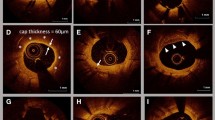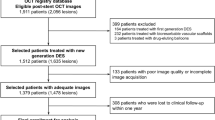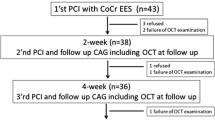Abstract
The healing process of acute incomplete stent apposition (ISA) in the early phase after stent implantation has not been well understood. We evaluated the temporal changes of ISA during the early phase after everolimus-eluting stent (EES) implantation using serial optical coherence tomography (OCT) analyses. Serial OCT examinations were performed immediately post-stenting and 2-week and 4-month after EES implantation for patients with ST-segment elevation myocardial infarction. At the most proximal cross-section of the implanted stent, the prevalence of ISA and maximum ISA distance were serially evaluated. In 45 patients with ST-segment elevation myocardial infarction, serial OCT analyses at 2-week and 4-month were performed. The prevalence of ISA gradually decreased over time, being 53.3% at baseline, 37.8% at 2-week follow-up, and 11.1% at 4-month follow-up (P < 0.001). The maximum ISA distance also decreased over time (P < 0.001). A receiver-operating curve analysis found that the optimal cut-off values of the baseline ISA distance for predicting persistent ISA at 2-week follow-up and 4-month follow-up were > 140 µm and > 215 µm, respectively. The baseline ISA distance was closely associated with the healing of ISA in the early phase after EES implantation. Maintaining the minimum ISA distance at post-stenting facilitates early phase healing of acute ISA.


Similar content being viewed by others
Abbreviations
- ISA:
-
Incomplete stent apposition
- OCT:
-
Optical coherence tomography
- EES:
-
Everolimus-eluting stent
- DAPT:
-
Dual antiplatelet therapy
- ROC:
-
Receiver operating characteristic
- HBR:
-
High-bleeding risk
References
Agrawal M, Hakeem A, Ahmed Z, Uretsky BF (2017) Classification of mechanisms of strut malapposition after angiographically optimized stent implantation: an optical coherence tomography study. Catheter Cardiovasc Interv 90(2):225–232
Lee SY, Ahn CM, Yoon HJ, Hur SH, Kim JS, Kim BK et al (2018) Early follow-up optical coherence tomographic findings of significant drug-eluting stent malapposition. Circ Cardiovasc Interv 11(12):e007192
Soeda T, Uemura S, Park SJ, Jang Y, Lee S, Cho JM et al (2015) Incidence and clinical significance of poststent optical coherence tomography findings: one-year follow-up study from a multicenter registry. Circulation 132(11):1020–1029
Prati F, Romagnoli E, Burzotta F, Limbruno U, Gatto L, La Manna A et al (2015) Clinical impact of OCT findings during PCI: the CLI-OPCI II study. JACC Cardiovasc Imaging 8(11):1297–1305
Cook S, Wenaweser P, Togni M, Billinger M, Morger C, Seiler C et al (2007) Incomplete stent apposition and very late stent thrombosis after drug-eluting stent implantation. Circulation 115(18):2426–2434
Adriaenssens T, Joner M, Godschalk TC, Malik N, Alfonso F, Xhepa E et al (2017) Optical coherence tomography findings in patients with coronary stent thrombosis: a report of the PRESTIGE consortium (prevention of late stent thrombosis by an interdisciplinary global european effort). Circulation 136(11):1007–1021
Souteyrand G, Amabile N, Mangin L, Chabin X, Meneveau N, Cayla G et al (2016) Mechanisms of stent thrombosis analysed by optical coherence tomography: insights from the national PESTO French registry. Eur Heart J 37(15):1208–1216
Raber L, Mintz GS, Koskinas KC, Johnson TW, Holm NR, Onuma Y et al (2018) Clinical use of intracoronary imaging. Part 1: guidance and optimization of coronary interventions. An expert consensus document of the European Association of Percutaneous Cardiovascular Interventions. Eur Heart J 39(35):3281–3300
Sotomi Y, Onuma Y, Dijkstra J, Miyazaki Y, Kozuma K, Tanabe K et al (2018) Fate of post-procedural malapposition of everolimus-eluting polymeric bioresorbable scaffold and everolimus-eluting cobalt chromium metallic stent in human coronary arteries: sequential assessment with optical coherence tomography in ABSORB Japan trial. Eur Heart J Cardiovasc Imaging 19(1):59–66
Shimamura K, Kubo T, Akasaka T, Kozuma K, Kimura K, Kawamura M et al (2015) Outcomes of everolimus-eluting stent incomplete stent apposition: a serial optical coherence tomography analysis. Eur Heart J Cardiovasc Imaging 16(1):23–28
Gutierrez-Chico JL, Wykrzykowska J, Nuesch E, van Geuns RJ, Koch KT, Koolen JJ et al (2012) Vascular tissue reaction to acute malapposition in human coronary arteries: sequential assessment with optical coherence tomography. Circ Cardiovasc Interv 5(1):20–29, S1-8
Shimoda M, Ando H, Naito K, Suzuki A, Sakurai S, Nakano Y et al (2018) Early-phase vascular healing of bioabsorbable vs. durable polymer-coated everolimus-eluting stents in patients with ST-elevation myocardial infarction- 2-week and 4-month analyses with optical coherence tomography. Circ J 82(10):2594–2601
Tearney GJ, Regar E, Akasaka T, Adriaenssens T, Barlis P, Bezerra HG et al (2012) Consensus standards for acquisition, measurement, and reporting of intravascular optical coherence tomography studies: a report from the International Working Group for Intravascular Optical Coherence Tomography Standardization and Validation. J Am Coll Cardiol 59(12):1058–1072.
Fujii K, Kubo T, Otake H, Nakazawa G, Sonoda S, Hibi K et al (2020) Expert consensus statement for quantitative measurement and morphological assessment of optical coherence tomography. Cardiovasc Interv Ther 35(1):13–18
Prati F, Guagliumi G, Mintz GS, Costa M, Regar E, Akasaka T et al (2012) Expert review document part 2: methodology, terminology and clinical applications of optical coherence tomography for the assessment of interventional procedures. Eur Heart J 33(20):2513–2520
Levine GN, Bates ER, Bittl JA, Brindis RG, Fihn SD, Fleisher LA et al (2016) 2016 ACC/AHA guideline focused update on duration of dual antiplatelet therapy in patients with coronary artery disease: a report of the american college of cardiology/american heart association task force on clinical practice guidelines. J Am Coll Cardiol 68(10):1082–1115
Valgimigli M, Bueno H, Byrne RA, Collet JP, Costa F, Jeppsson A et al (2018) 2017 ESC focused update on dual antiplatelet therapy in coronary artery disease developed in collaboration with EACTS: the Task Force for dual antiplatelet therapy in coronary artery disease of the European Society of Cardiology (ESC) and of the European Association for Cardio-Thoracic Surgery (EACTS). Eur Heart J 39(3):213–260
Nakamura M, Kimura K, Kimura T, Ishihara M, Otsuka F, Kozuma K et al (2020) JCS 2020 guideline focused update on antithrombotic therapy in patients with coronary artery disease. Circ J 84(5):831–865
Mehran R, Baber U, Sharma SK, Cohen DJ, Angiolillo DJ, Briguori C et al (2019) Ticagrelor with or without aspirin in high-risk patients after PCI. N Engl J Med 381(21):2032–2042
Hahn JY, Song YB, Oh JH, Chun WJ, Park YH, Jang WJ et al (2019) Effect of P2Y12 inhibitor monotherapy vs dual antiplatelet therapy on cardiovascular events in patients undergoing percutaneous coronary intervention: the SMART-CHOICE randomized clinical trial. JAMA 321(24):2428–2437
Vranckx P, Valgimigli M, Juni P, Hamm C, Steg PG, Heg D et al (2018) Ticagrelor plus aspirin for 1 month, followed by ticagrelor monotherapy for 23 months vs aspirin plus clopidogrel or ticagrelor for 12 months, followed by aspirin monotherapy for 12 months after implantation of a drug-eluting stent: a multicentre, open-label, randomised superiority trial. Lancet 392(10151):940–949
Watanabe H, Domei T, Morimoto T, Natsuaki M, Shiomi H, Toyota T et al (2019) Effect of 1-month dual antiplatelet therapy followed by clopidogrel vs 12-month dual antiplatelet therapy on cardiovascular and bleeding events in patients receiving PCI: the STOPDAPT-2 Randomized Clinical Trial. JAMA 321(24):2414–2427
Iakovou I, Schmidt T, Bonizzoni E, Ge L, Sangiorgi GM, Stankovic G et al (2005) Incidence, predictors, and outcome of thrombosis after successful implantation of drug-eluting stents. JAMA 293(17):2126–2130
van Werkum JW, Heestermans AA, Zomer AC, Kelder JC, Suttorp MJ, Rensing BJ et al (2009) Predictors of coronary stent thrombosis: the Dutch Stent Thrombosis Registry. J Am Coll Cardiol 53(16):1399–1409
Guo N, Maehara A, Mintz GS, He Y, Xu K, Wu X et al (2010) Incidence, mechanisms, predictors, and clinical impact of acute and late stent malapposition after primary intervention in patients with acute myocardial infarction: an intravascular ultrasound substudy of the Harmonizing Outcomes with Revascularization and Stents in Acute Myocardial Infarction (HORIZONS-AMI) trial. Circulation 122(11):1077–1084
Romagnoli E, Gatto L, La Manna A, Burzotta F, Taglieri N, Saia F et al (2017) Role of residual acute stent malapposition in percutaneous coronary interventions. Catheter Cardiovasc Interv 90(4):566–575
Nakano M, Yahagi K, Otsuka F, Sakakura K, Finn AV, Kutys R et al (2014) Causes of early stent thrombosis in patients presenting with acute coronary syndrome: an ex vivo human autopsy study. J Am Coll Cardiol 63(23):2510–2520
Iliescu CA, Cilingiroglu M, Giza DE, Rosales O, Lebeau J, Guerrero-Mantilla I et al (2017) "Bringing on the light” in a complex clinical scenario: optical coherence tomography-guided discontinuation of antiplatelet therapy in cancer patients with coronary artery disease (PROTECT-OCT registry). Am Heart J 194:83–91
Author information
Authors and Affiliations
Contributions
All authors contributed to the study conception and design. Material preparation, data collection and analysis were performed by [HW], [MS], [HO], [AS] and [SS]. The first draft of the manuscript was written by [HA] and all authors commented on previous versions of the manuscript. All authors read and approved the final manuscript.
Corresponding author
Ethics declarations
Conflict of interest
All authors have reported that they have no relationships relevant to the contents of this paper to disclose.
Additional information
Publisher's Note
Springer Nature remains neutral with regard to jurisdictional claims in published maps and institutional affiliations.
Electronic supplementary material
Below is the link to the electronic supplementary material.
Rights and permissions
About this article
Cite this article
Wakabayashi, H., Ando, H., Nakano, Y. et al. Temporal changes of incomplete stent apposition during early phase after everolimus-eluting stent implantation: serial optical coherence tomography analyses at 2-week and 4-month. Int J Cardiovasc Imaging 37, 411–417 (2021). https://doi.org/10.1007/s10554-020-02023-z
Received:
Accepted:
Published:
Issue Date:
DOI: https://doi.org/10.1007/s10554-020-02023-z




